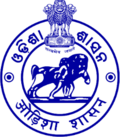Gajapati district | |
|---|---|
Clockwise from top-left: Khasada Waterfall, Mahendragiri Hills, Padmasambhava Mahavihara monastery, Gandahati waterfall, B.N. Palace, Mahendragiri Temple, Gajapati Palace | |
 Location in Odisha | |
| Coordinates: 19°02′N84°12′E / 19.03°N 84.2°E | |
| Country | |
| State | |
| CD Blocks and Tahasils | 07 |
| District Formation | October 2, 1992 |
| Named after | Maharaja Krushna Chandra Gajapati Narayan Deo |
| Headquarter | Paralakhemundi |
| CD Blocks and Tahasils | Gosani Kashinagar Gumma Rayagada Nuagada R. Udayagiri Mohana |
| Government | |
| • District Collector and District Magistrate | Madhumita, IAS |
| • Superintendent of Police | Jatindra Kumar Panda, OPS |
| Area | |
• Total | 3,850 km2 (1,490 sq mi) |
| • Rank | 16th |
| Elevation | 1,501 m (4,925 ft) |
| Population (2025) | |
• Total | 826,127 |
| • Rank | 28th |
| • Density | 212/km2 (550/sq mi) |
| Demonym | Gajapatia |
| Languages | |
| • Official | Odia, English |
| • Tribal | Sora • Kui |
| Time zone | UTC+5:30 (IST) |
| PIN | 761 xxx |
| Telephone code | 06815 Paralakhemundi 06816 Mohana 06817 R. Udayagiri |
| Vehicle registration | OD-20 |
| Nearest city | Brahmapur |
| Sex ratio | 1046 ♂/♀ |
| Literacy | 53.49% |
| House of the People Constituency | Brahmapur |
| Legislative Assembly Constituency | 2
|
| Climate | Aw (Köppen) |
| Precipitation | 1,403.3 millimetres (55.25 in) |
| Avg. summer temperature | 43 °C (109 °F) |
| Avg. winter temperature | 09 °C (48 °F) |
| Website | www |
Gajapati district is a district of Odisha State in India. It was carved out of Ganjam District on October 2, 1992. As of 2011 it was the third least populous district of Odisha (out of 30), after Debagarh and Boudh. [1] Gajapati district was named after Krushna Chandra Gajapati Narayan Deb, the King of the Paralakhemundi estate and the first Prime Minister of Odisha, who is remembered for his contribution to the formation of a separate state, and inclusion of his estate in Odisha. The district headquarters in Paralakhemundi, formerly a Zamindari, is clustered within a radius of approximately 5 kilometers around its geometric center.










